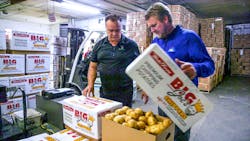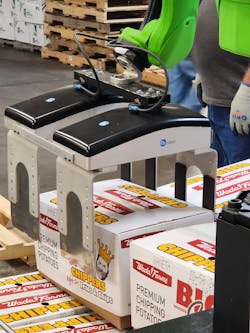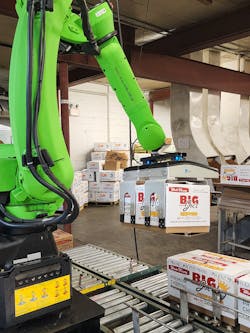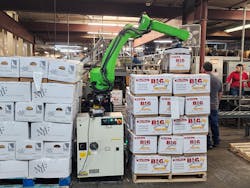Heavy-Duty Collaborative Palletizing System Addresses Potato Industry’s Labor Shortages
At a Glance:
- Magic Valley Produce researched automation options to solve impending labor shortages.
- The company faced numerous challenges for palletizing, including limited floor space and headroom, heavy payload and two-piece, slip-top cardboard boxes that couldn’t be lifted using traditional vacuum grippers.
- An innovative collaborative deployment solved all of those issues—safely and cost-effectively. Two customized OnRobot 2FGP20 finger grippers mounted together on an industrial-strength FANUC CR-35iB cobot provide a game-changing solution.
Dean Gibson’s family has been producing and packaging potatoes for generations from the heart of Idaho’s prime potato-growing region.
“One of our biggest challenges absolutely is labor, especially on the palletizing line,” said Gibson, co-owner and controller of Magic Valley Produce.
The company operates from a low-slung building that has changed little since its founding in 1964. With 42 employees, Magic Valley is by far the largest employer in the town of Paul, population 1,441. Many of Magic Valley’s employees have been with the company for more than three decades, and the average age of the palletizing workforce is now 63 years old. As those valued workers begin to retire, there is a limited labor pool to replace them.
Currently, Magic Valley stacks eight pallets at a time, with four to six people working full time, year-round lifting 52.5-lb boxes over their heads for the top layers. With a robot able to stack two pallets at a time, a single supervisor could easily manage multiple pallets with a lower possibility of injury.
“Our goal was never to replace anybody, but with an aging workforce, and it being harder to find people all the time, it’s just become more of a necessity,” Gibson explained. “That was one of our biggest fears moving forward.”
The strain on the labor pool is especially true of the palletizing line, which is critical to getting product out the door. “As people retire, and as things change, I just need to have options, and this is definitely a huge part of having options going forward,” he said.
Gibson researched his options and discovered three major challenges to automating the palletizing line. First, the building itself has little available floor space and overhead space, making it difficult to find a robot small enough to fit into the existing production floor. Second, the boxes are too heavy for most collaborative robots that could fit the space.
The third challenge proved to be the most difficult: The potatoes are packed in two-piece boxes with an unsecured slip top that makes it impossible to use traditional vacuum grippers, which would pull the tops off the boxes rather than lift them.
Dual Finger Grippers and Industrial-Strength Cobot Solve Space and Weight Challenges
Despite its tight quarters, Magic Valley packages 100 million pounds of potatoes a year, sorting them by size into 52.5-lb boxes (23.8 kg) for restaurants and food producers. Those boxes are then palletized up to seven layers high—more than six feet (1.8 m). Magic Valley produces 150 pallets per day, with almost a ton of potatoes per pallet.
Gibson was skeptical that a small, powerful and dependable palletizing system existed that would meet those demanding requirements. But when John Weeks, CEO of automation integrator WeAssistBots, walked through Gibson’s facility, he was confident he could meet the challenge. Weeks chose the FANUC CR-35iB cobot, with an industry-leading payload of 35 kg (77 lb) and reach of 1831 mm (74 in).
READ MORE: Universal Robots Unveils UR30: Relief for Heavy Lifting
“It brought the horsepower required to do 50-lb cases in the Idaho potato industry, that up until now a traditional cobot couldn’t touch,” Weeks explained. The cobot also combined the small installation footprint and large work envelope that Magic Valley needed. The cobot can stack two pallets at once (one on either side of the robot), reaching easily from floor to ceiling, and actually taking up about 18 fewer inches than having workers in that area.
In an innovative approach, Weeks mounted two rugged OnRobot 2FGP20 electric finger grippers on the cobot arm to handle the 52.5-lb boxes. This approach doubled the tool’s individual payload of 20 kg (44 lb).
Weeks credited the quick response from OnRobot’s technical team to make the integration work. When he and his engineers encountered some hiccups with mounting the dual tools, he called his OnRobot contact and received immediate technical support. With the additional information, Weeks and his team of engineers were able to make the appropriate adaptations for a successful deployment.
OnRobot Adaptability and Customizability Solves Gripping Challenge, Inspires Confidence
With the weight and footprint issues addressed, the slip-top box challenge required additional innovation. According to Weeks, that’s where OnRobot really shines. “My favorite thing about OnRobot tooling is absolutely their adaptability and the customizability,” he said.
Weeks attached a metal plate with curved fingers on one side of the dual grippers, then programmed the robot arm to angle the tool so it tucks the curved fingers under the bottom of the box before lifting it. “With the customizability of the 2FGP20 versatile tooling, we were able to get both finger grippers underneath the edge of the box with 40 nanometers of force, compress that box, and deliver it gently and quickly and safely,” he explained.
“Before, you always had to make your own custom tooling, and you had to hope that it would work,” Weeks said. But with a proven, warrantied and immediately available OnRobot gripper, Weeks pointed out that the company now has a single tool that “is off-the-shelf ready, tried-and-true tested, and will literally do the job over and over and over again without any interruptions.”
Gibson credits the OnRobot tooling for the palletizer’s success. “The gripper in particular is what made the whole system come together because it was crucial to keep the two-piece, 52.5-lb box together, and be able to pick it up and place it,” he said. “That is the only reason why this all worked for us, and that’s to John’s credit and to OnRobot for being able to collaborate and make that happen.”
Collaborative Palletizer is Smaller, More Versatile, and Costs a Third of the Price of Traditional Systems
Magic Valley’s palletizer is a prime example of a new wave of powerful collaborative applications, making automation viable for smaller agricultural producers.
In an earlier automation effort, Gibson had invested in a traditional palletizing system to handle large bags of potatoes that are packaged for retail sales. While the system worked well for that process, it required a huge footprint at one end of the facility for the dedicated conveying system and palletizer, as well as the required large safety cage. And the system could only palletize one product line, compared to the smaller and more versatile collaborative system.
READ MORE: 5 Ways Cobots Are Boosting the Efficiency of Automotive Manufacturing Processes
“The more traditional systems are a lot more expensive, Gibson explained. “They take up a ton of space and they take up a lot of money, too.” Comparing the new collaborative palletizer to more traditional systems, he said this system is about a third of the price. “And that’s a game-changer for me; it’s so much more cost-effective, and ROI is so much better than any other options that were out there.”
Gibson said there are many facilities in the potato industry that are both older and size-constrained. An automated plan could provide a cost-effective option, he said.
Automation Plan Includes More OnRobot-Powered Palletizers, Providing Options for Alleviating Labor Shortages
Weeks has worked with Gibson to develop an automation plan that Magic Valley can confidently deploy over time, using the collaborative palletizing solution with the FANUC cobot and OnRobot tooling along with new optical sorting systems.
“With the three to four robots in staging and everything that we’re going to have to do to make it all function, it is still a fraction of what some of these other systems are,” Gibson said. “And going back to floor space, this is really hands-down the best option for us.”
Automation also offers new opportunities for employees and more attractive positions for hiring and retaining workers. Gibson viewed finding people who are willing and able to work with automation as an additional challenge. But while some of his workers initially felt intimidated by the equipment, others have stepped up to learn how to use the technology and run the new systems, increasing their value.
“The more automation that you know how to run, the more secure your job is,” he noted.
Now lead robot technician, Jose Santa Cruz recollected being nervous when he first learned to use the application. “But it’s all kind of common sense; it’s like a computer,” he mused.
Santa Cruz said he had seen family and colleagues with back injuries from manual labor. “I can see how this could stop all that,” he said. “People would be healthier. I think there’s going to be more opportunities for me in the future.”
Kristian Hulgard is general manager of OnRobot Americas.





